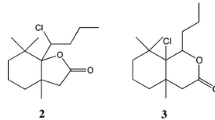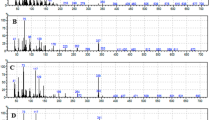Abstract
The activity of a methanol extract residue fromCladophora glomerata against larvae ofAedes triseriatus is confirmed. Fractionation of this residue by solubility in solvents of varying polarity is monitored by bioassay withA. triseriatus larvae. The presence of fatty acids in the active hexane soluble fraction and saponified material obtained therefrom is indicated by1H NMR and IR. The identification of the individual fatty acids is achieved by co-injection and mass GLC of their methyl esters. Saturated and unsaturated fatty acids are screened against larvae and the LD50 values of the most active acids are determined. The LD50 of capric [10∶0], lauric [12∶0], myristic [14∶0] and palmitoleic [16∶1 (9c)] are 14,7, 4 and 3ppm respectively. The most active acids 12∶0, 14∶0 and 16∶1 (9c) are present in all the fractions examined and are released to water by the powdered alga at pH 8.5.
Similar content being viewed by others
References
Amonkar, S.V. 1969. Fresh water algae and their metabolites as a means of biological control of mosquitoes. PhD thesis. Univ. of Calif. Riverside.
Cason, J., Wolfhagen, H., Tarpey, W., andAdams, R.E. 1959. Synthesis of acids with branching methyl groups near the carboxyl.J. Org. Chem. 14:147–154.
Gunstone, F.D. 1967. An Introduction to the Chemistry and Biochemistry of Fatty Acids and Their Glycerides, 2nd ed., p. 12, Chapman and Hall, Ltd., Bungay, Suffolk.
Ikeshoji, T., andMulla, M.S. 1974. Overcrowding factors of mosquito larvae: Activity of branched fatty acids against mosquito larvae.Environ. Enlomol. 3:487–491.
Maw, M.G., andHouse, H.L. 1971. On capric acid and potassium capricate as mosquito larvicides in laboratory and field.Can. Entomol. 103:1435–1440.
Mills, E.L., andForney, J.L. 1977. Primary and secondary production in the St. Lawrence River system, pp. 20 and 25,In J.W. Geis, (ed.). Preliminary Report: Biological Characteristics of the St. Lawrence River. State University College of Environmental Science and Forestry, Institute of Environmental Program Affairs, Syracuse, New York.
Prescott, G.W. 1951. Algae of the Great Western Lakes Area, pp. 136 and 138, Cranbrook Press, Bloomfield Hills, Michigan.
Puritch, G.S. 1975. The toxic effects of fatty acids and their salts on the balsam woolly aphid,Adeges piceae (Ratz.).Can. J. For. Res. 5:515–522.
Reeves, E.L. 1970. Pathogens of mosquitoes. Proceedings and Papers of the Thirty-Eighth Annual Conference of the California Mosquito Control Associations, Inc. January 26–29.
Author information
Authors and Affiliations
Rights and permissions
About this article
Cite this article
LaLonde, R.T., Morris, C.D., Wong, C.F. et al. Response ofAedes triseriatus larvae to fatty acids ofCladophora . J Chem Ecol 5, 371–381 (1979). https://doi.org/10.1007/BF00987923
Received:
Revised:
Issue Date:
DOI: https://doi.org/10.1007/BF00987923




